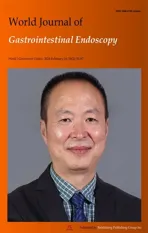Association between triglyceride-glucose index and colorectal polyps: A retrospective cross-sectional study
2024-03-07YaJieTengYingXueYangJingJingYangQiuYanLuJiaYiShiJianHaoXuJieBaoQingHuaWang
Ya-Jie Teng,Ying-Xue Yang,Jing-Jing Yang,Qiu-Yan Lu,Jia-Yi Shi,Jian-Hao Xu,Jie Bao,Qing-Hua Wang
Abstract BACKGROUND Colorectal polyps (CPs) are frequently occurring abnormal growths in the colorectum,and are a primary precursor of colorectal cancer (CRC).The triglyceride-glucose (TyG) index is a novel marker that assesses metabolic health and insulin resistance,and has been linked to gastrointestinal cancers.AIM To investigate the potential association between the TyG index and CPs,as the relation between them has not been documented.METHODS A total of 2537 persons undergoing a routine health physical examination and colonoscopy at The First People's Hospital of Kunshan,Jiangsu Province,China,between January 2020 and December 2022 were included in this retrospective cross-sectional study.After excluding individuals who did not meet the eligibility criteria,descriptive statistics were used to compare characteristics between patients with and without CPs.Logistic regression analyses were conducted to determine the associations between the TyG index and the prevalence of CPs.The TyG index was calculated using the following formula: Ln [triglyceride (mg/dL) × glucose (mg/dL)/2].The presence and types of CPs was determined based on data from colonoscopy reports and pathology reports.RESULTS A nonlinear relation between the TyG index and the prevalence of CPs was identified,and exhibited a curvilinear pattern with a cut-off point of 2.31.A significant association was observed before the turning point,with an odds ratio (95% confidence interval) of 1.70 (1.40,2.06),P < 0.0001.However,the association between the TyG index and CPs was not significant after the cut-off point,with an odds ratio (95% confidence interval) of 0.57 (0.27,1.23),P=0.1521.CONCLUSION Our study revealed a curvilinear association between the TyG index and CPs in Chinese individuals,suggesting its potential utility in developing colonoscopy screening strategies for preventing CRC.
Key Words: Triglyceride-glucose index;Colorectal polyps;Colorectal cancer;Insulin resistance;Cross-sectional study
INTRODUCTION
Colorectal polyps (CPs) are common abnormal growths and protrusions on the surface of the colon and rectum[1].There are various types,including adenomatous polyps and hyperplastic polyps,and they are recognized as the most common precursors of colorectal cancer (CRC)[2].Adenomatous polyps are the most frequently observed premalignant lesions preceding the development of CRC,and CRC is the most commonly diagnosed cancer and the second most common cause of cancer death after lung cancer[3,4].The incidence of CPs and CRC has been steadily increasing worldwide in recent decades,making them a significant public health concern[5].Early detection and removal of CPs are crucial for preventing the development of CRC[6].Identifying risk factors associated with CPs can help in developing effective screening strategies and implementing preventive measures[7].Several risk factors have been identified for the development of CPs,including age,family history of CRC,genetic predisposition,dietary factors,and lifestyle choices such as smoking and alcohol consumption[8].However,there is still a need to explore additional risk factors that may contribute to the development of CPs.
The triglyceride-glucose (TyG) index is a novel marker that has gained significant attention in recent research.It is a composite index that combines the levels of fasting plasma glucose and fasting triglycerides,and provides a comprehensive assessment of metabolic health[9].Recently,the TyG index has become a popular method for assessing insulin resistance (IR),a forerunner of type 2 diabetes[10].Studies have demonstrated that an elevation of the TyG index correlates with cardiovascular diseases,depression,erectile dysfunction,and gastrointestinal cancers[11-14].However,its association with CPs is not clear.
Accumulating evidence has shown that IR may increase the risk of CPs.Qinet al[15] reported a significant correlation between IR and the occurrence of CPs and adenomatous polyps.Furthermore,Kekuet al[16] conducted a comprehensive study involving 239 patients with colorectal adenoma and 517 adenoma-free persons,and the results suggested that IR is significantly associated with an elevated risk of developing adenomatous polyps.Additionally,the study revealed a decrease in apoptosis within the normal rectal mucosa among individuals with IR.Similarly,Floodet al[17] found that patients with elevated levels of insulin and glucose have a higher risk of recurrence of adenomatous polyps.Notably,patients with increased glucose levels exhibited an even greater increase in the risk of recurrent advanced adenomatous polyps.
Therefore,the purpose of this study was to investigate the potential association between the TyG index and CPs in a Chinese population.Understanding this association may provide valuable insights into the pathogenesis and early detection of CPs,leading to improved screening strategies and better prevention of CRC.
MATERIALS AND METHODS
Study population
The study included asymptomatic individuals who underwent colonoscopy as part of a comprehensive health screening program at The First People's Hospital of Kunshan,China,between January 2020 and December 2022.The retrospective review included patients between 18 and 79 years of age.Exclusion criteria consisted of incomplete colonoscopy results,history of polypectomy,inflammatory bowel disease,previous CRC or colorectal surgery,familial colonic polyposis,and detection of a colorectal tumor during the examination.The total number of patients included in this study was 2537 (Figure 1).The ethical committee of The First People's Hospital of Kunshan,China,approved the study,and the requirement for informed consent was waived due to its retrospective nature and the use of de-identified secondary data.
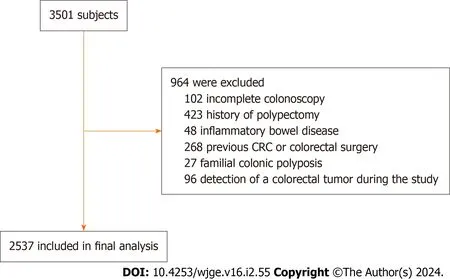
Figure 1 Flow diagram of patient inclusion and exclusion. CRC: Colorectal cancer.
Biochemical analyses
After a 12-h overnight fasting period,blood samples were obtained from each participant.Biochemical analysis of the blood samples was performed using routine enzymatic methods on the VITROS 5600 Integrated System.The blood samples were tested for serum levels of triglycerides (TG),total cholesterol (TC),high-density lipoprotein cholesterol (HDL-C),low-density lipoprotein cholesterol (LDL-C),fasting plasma glucose (FPG),and uric acid (UA).Additionally,the concentrations of serum aspartate aminotransferase (AST) and alanine aminotransferase (ALT) were determined using previously described methodologies.The TyG index was calculated as Ln [triglycerides (mg/dL) × fasting glucose (mg/dL)/2][18].
Colonoscopy and pathological examination
Prior to colonoscopy,all patients underwent a bowel preparation involving the use of polyethylene glycol electrolyte powder.The colonoscopies were performed using an ELUXEO 7000 endoscope system (FUJIFILM,Japan) by highly skilled gastroenterologists with a minimum of 5 years of experience in performing colonoscopies.Each endoscopist had performed over 1000 colonoscopies,and performed 6 or more colonoscopy examinations per day.Successful completion of the colonoscopy examination was defined as traversal of the colonoscope to the cecum,which was achieved in 97% of cases.
Pertinent colonoscopy features recorded included the presence or absence of polyps,which were subsequently biopsied or removed.The CPs included adenomatous and non-adenomatous polyps,and patients with polyps diagnosed as malignant were excluded from the study.The histological assessment of the polyps followed the established criteria outlined by the World Health Organization,and was conducted by experienced pathologists.Based on the combined colonoscopy and pathological findings,the patients were categorized into 2 distinct groups: A polyp-free group and a colorectal polyps group (one or more polyps).A subgroup analysis was also performed on the group with adenomatous polyps.
Statistical analysis
All statistical analyses were performed with R (version 3.5.3) software.Demographic data and risk factors associated with CPs were reported as mean ± SD,or count (percentage).The Kruskal-Wallis test was used to compare continuous variables,while Fisher's exact test was used to compare categorical variables.Multivariate logistic regression was conducted to identify risk factors associated with both adenomatous and non-adenomatous polyps.The consistency of relation was inspected through the use of linear trend tests.Generalized Additive Models (GAMs) and smooth curve fittings were used to examine potential non-linear associations.From the smoothing curve,the turning point was calculated using a recursive algorithm before being subjected to a 2-piecewise linear regression model.A value ofP< 0.05 was considered statistically significant.
RESULTS
Baseline characteristics
The general characteristics of the study population in relation to colonoscopic findings are summarized in Table 1.In comparison to the polyp-free group,patients with CPs were older and predominantly male.The polyp-free group had lower levels of AST,and higher levels of TGs,TC,LDL-C,HDL-C,UA,and FPG,and a higher TyG index (Table 1).
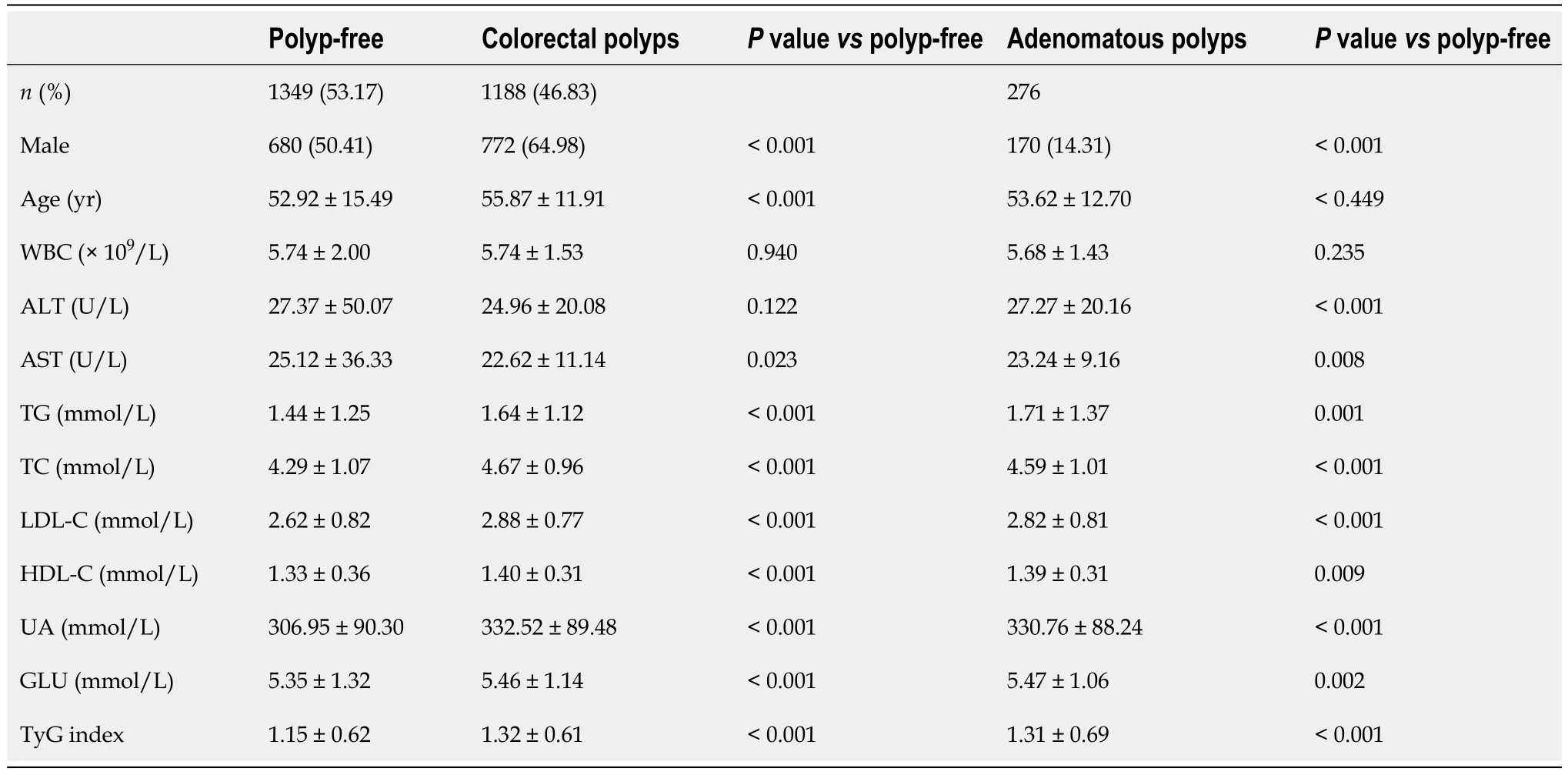
Table 1 Demographic and clinical characteristics of the subjects according to colonoscopic findings
Association between TyG index and CPs
A positive correlation between the TyG index and the risk of CPs was identified (Table 2).The association remained significant after adjusting for different variables.In Model I,no covariates were adjusted;in Model II,age and sex were adjusted;and in Model III adjustment was made for age,sex,TC,LDL-C,and HDL-C.The positive association persisted in Model III [odds ratio (OR)=1.56;95% confidence interval (CI): 1.03–1.86;P< 0.0001].These results indicate that each unit increase in the TyG index was associated with a 56% higher risk of CPs.Stratifying the data by age or sex revealed consistent positive associations similar to those observed without stratification (Table 2).
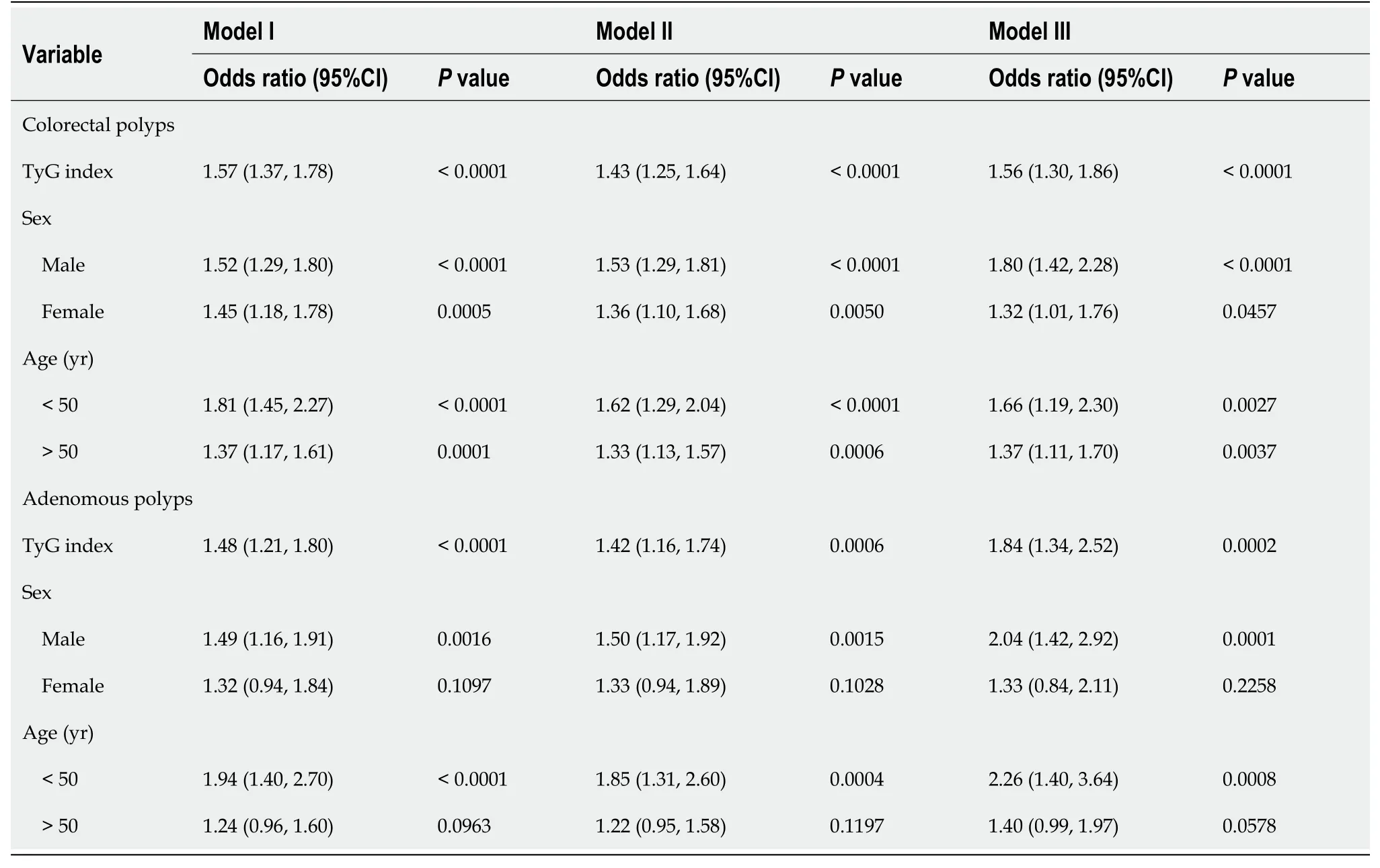
Table 2 Adjusted ORs and 95%CIs for the occurrence of colorectal polyps in relation to triglyceride-glucose index based on multinomial logistic regression
The relation between the TyG index and the prevalence of CPs was non-linear,as evidenced by the GAM and smoothing curve analyses (Figure 2).Specifically,a curvilinear pattern with a cut-off point at 2.31 was identified.A significant association was detected before the cut-off point (OR=1.70;95%CI: 1.40–2.06;P< 0.0001).However,after the cut-off point the association was no longer significant (OR=0.57;95%CI: 0.27-1.23;P=0.1521) (Table 3).

Table 3 Threshold effect analysis of triglyceride-glucose index on for the occurrence of colorectal polyps using a two-piecewise linear regression model
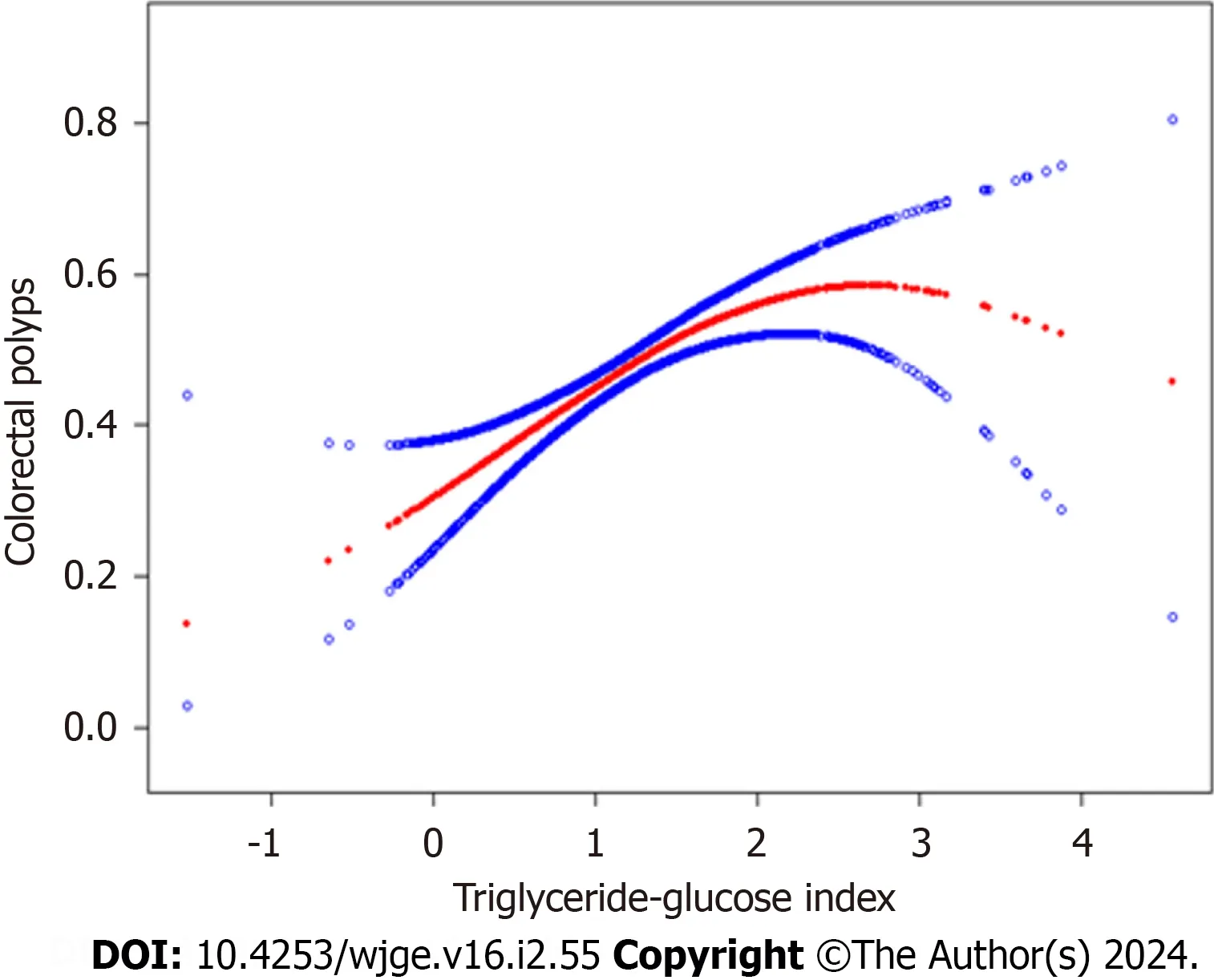
Figure 2 The association between triglyceride-glucose index and colorectal polyps. Age,sex,total cholesterol,high-density lipoprotein cholesterol and low-density lipoprotein cholesterol were adjusted.
DISCUSSION
In this cross-sectional study conducted within a Chinese population,we examined the correlation between the TyG index and CPs.We observed a persistent positive association,even after adjusting for variables such as sex,age,TC,HDL-C,and LDL-C.The relation was non-linear,with a significant turning point at 2.31.Notably,prior to the turning point each unit increase in the TyG index was associated with a 56% higher risk of CPs.This study is the first to investigate the association between the TyG index and CPs in a Chinese population.It is also the first study to uncover a non-linear association between the TyG index and CPs,and subsequently conduct a threshold effects analysis to further examine the non-linear relation.
Our results showed a critical threshold at 2.31 in the non-linear relation between the TyG index and CPs.Specifically,our results suggest that increasing TyG index values are significantly associated with an increased risk of developing CPs up to the turning point of 2.31.Beyond this threshold the relation was no longer statistically significant.It is well established that the magnitude of the TyG index is positively associated with IR.Recently,the TyG index has been verified as a simple and dependable estimate of IR,and it is comparable to the euglycemic-hyperinsulinemic clamp method,which is considered the gold standard for evaluating IR[19].Therefore,we postulate that treatment and management of IR might be beneficial to prevent the occurrence and progression of CPs and CRC.
Previous research has established a significant association between the TyG index and the development of CRC.It has also suggested that the TyG index should be considered an important factor in determining the need for screening colonoscopy.Okamuraet al[20] conducted a historical cohort study involving 27944 participants (16454 men and 11490 women) to examine the impact of the TyG index on incident CRC.They used a Cox proportional hazard model and adjusted for covariates,and revealed a hazard ratio of 1.38 (95%CI: 1.00-1.91;P=0.049) for the TyG index.Their covariate-adjusted receiver operating characteristic (ROC) curve analysis identified a cut-off value of 8.27 for the TyG index in relation to incident CRC [area under the ROC curve (AUC)=0.687,95%CI: 0.637-0.737,sensitivity=0.620,specificity=0.668,P< 0.001].These results suggest that the TyG index has predictive ability for the development of CRC.A prospective cohort study by Liuet al[21] investigated 93659 cancer-free participants in Northern China,and assed the TyG index and the TG/HDL-C ratio.The results showed an increased risk of developing CRC in adults with an elevated TyG index and TG/HDL-C ratio.The aforementioned studies support an association between and elevated TyG index and the development of CRC.Given that CPs have been shown to be associated with the development of CRC,it is imperative to delve further into the relation between CPs and the TyG index.Such investigation would provide novel evidence for the prevention of CRC.
The exact mechanisms underlying the relation between the TyG index and CRC development are not fully understood.However,there is substantial evidence linking IR to CRC,and the TyG index is a validated surrogate marker for IR,comparable to the commonly used Homeostatic Model Assessment of IR index[22].Thus,it is biologically plausible to consider an elevated TyG index as a risk factor for CRC.
Previous studies have shown that IR is a significant risk factor for the development of CRC.Insulin and insulin-like growth factor (IGF) may contribute to CRC development through their anti-apoptotic and mitogenic effects[23].In a Mendelian randomization analysis conducted by Murphyet al[24] that used blood samples from nearly 400000 persons in the United Kingdom Biobank,an association between circulating levels of IGF1 and CRC was demonstrated.Using genetic data from over 52000 patients with CRC and 46000 persons without CRC,they observed that genetically determined higher levels of IGF1 were associated with an increased risk of CRC.These findings suggest that the interaction of various processes,directly or indirectly regulated by IGF-1,may contribute to CRC development.
Previous studies have also shed light on the role of insulin/IGF-1 in CRC.It has been shown that insulin/IGF-1 activate signaling pathways such as PI3K/Akt/mTORC and Raf/MAPK,thereby promoting cancer progression.In addition,insulin/IGF-1 activation leads to the activation of glucose transporters like GLUT1 and key glycolytic enzymes including LDHA,LDH5,HK II,and PFKFB3.Moreover,abnormal expression of oncogenes such asMYCandKRAS,as well as overexpression of signaling proteins like HIF-1,TGF-β1,PI3K,ERK,Akt,and mTOR,have been observed in CRC[25-29].
Our study has several limitations which we would like to acknowledge.First,while missing data of covariates were assumed to be missing randomly and the sample size was adequately large to draw a conclusion,we did not use multiple imputation to account for the missing data,which may potentially affect the accuracy of the results.Second,since this was a cross-sectional study,causality between the TyG index and the risk of CPs cannot be determined.Third,this study was conducted at a single center,and therefore multi-center studies should be carried out to verify our findings.
CONCLUSION
In summary,the TyG index,as a surrogate measure of IR,may potentially mediate the association between insulinrelated factors,such as IGF1,and the risk of CRC.Our results clearly demonstrate an association between the TyG index and the development of CPs,providing new evidence in support of colonoscopy screening.Despite the limitations of our study,our findings suggest the need for further research to evaluate the potential role of the TyG index in assessing therisk for CPs and identifying patients who would benefit from colonoscopy screening.
ARTICLE HIGHLIGHTS
Research background
Colorectal polyps (CPs) are widely recognized as precursors to colorectal cancer (CRC),posing a significant global health concern.The triglyceride-glucose (TyG) index,an emerging biomarker,has shown associations with metabolic health and insulin resistance,making it a subject of interest in gastrointestinal cancer research.
Research motivation
The increasing incidence of CPs and CRC worldwide underscores the need for effective screening strategies.This study aims to fill the gap in knowledge by exploring the potential link between the TyG index and CPs in a Chinese population.Understanding this relationship could have implications for developing preventative measures and screening strategies.
Research objectives
The primary objective is to investigate the association between the TyG index and CPs,marking a pioneering exploration in a Chinese demographic.The study endeavors to identify a potential turning point in this relationship,offering valuable insights for future research and interventions.
Research methods
The retrospective cross-sectional study involves 2537 participants undergoing health examinations and colonoscopies.Thoroughly described methods include participant selection criteria,TyG index calculation,and statistical analyses.By employing logistic regression and a comprehensive approach,the study aims to reveal the nuances of the TyG index's association with CPs.
Research results
The study unveils a non-linear relationship between the TyG index and CP prevalence,delineating a significant turning point at 2.31.The analysis indicates a heightened risk of CPs before this threshold,while the association diminishes beyond it.The results contribute to the understanding of the TyG index's role in colorectal health,with potential implications for risk assessment and screening strategies.
Research conclusions
This study's novel findings confirm a curvilinear association between the TyG index and colorectal polyps,with a critical cut-off point at 2.31.The persistent positive association before this point highlights the potential utility of the TyG index in identifying individuals at risk.This study's conclusion emphasizes the relevance of these findings in shaping colonoscopy screening strategies for CRC prevention.
Research perspectives
The study prompts further investigation into the mechanisms linking the TyG index,insulin resistance,and colorectal health.Advocating for multi-center studies,the research perspectives underscore the importance of validating findings across diverse populations.The TyG index's potential role in informing future screening guidelines and its broader applicability for assessing colorectal polyp risk remain promising avenues for future research.
FOOTNOTES
Co-first authors:Ya-Jie Teng and Ying-Xue Yang
Author contributions:Teng YJ,Yang YX,Yang JJ,Bao J,Shi JY,Xu JH and Wang QH participated in literature search,study design;Teng YJ,Yang YX,Yang JJ participated in data acquisition and wrote the manuscript;Teng YJ,Yang YX,Lu QY participated in interpretation of data;all authors read and approved the final manuscript.
Supported bySuzhou Municipal Science and Technology Program of China,No.SKJY2021012.
Institutional review board statement:The study was reviewed and approved by the Ethical Committee of the First People's Hospital of Kunshan (No.2023-03-026).
Informed consent statement:Patients were not required to give informed consent to the study because the analysis used anonymous clinical data.
Conflict-of-interest statement:The authors declared no conflict-of-interest.
Data sharing statement:Dataset available from the corresponding author at ksph_wqh@sina.com.
Open-Access:This article is an open-access article that was selected by an in-house editor and fully peer-reviewed by external reviewers.It is distributed in accordance with the Creative Commons Attribution NonCommercial (CC BY-NC 4.0) license,which permits others to distribute,remix,adapt,build upon this work non-commercially,and license their derivative works on different terms,provided the original work is properly cited and the use is non-commercial.See: https://creativecommons.org/Licenses/by-nc/4.0/
Country/Territory of origin:China
ORCID number:Ya-Jie Teng 0000-0003-0892-012X;Ying-Xue Yang 0009-0002-1130-1522;Qing-Hua Wang 0000-0002-2806-6154.
S-Editor:Gong ZM
L-Editor:A
P-Editor:Xu ZH
杂志排行
World Journal of Gastrointestinal Endoscopy的其它文章
- Retrospective analysis of discordant results between histology and other clinical diagnostic tests on helicobacter pylori infection
- Comparative efficacy and safety between endoscopic submucosal dissection,surgery and definitive chemoradiotherapy in patients with cT1N0M0 esophageal cancer
- Coca-Cola consumption vs fragmentation in the management of patients with phytobezoars: A prospective randomized controlled trial
